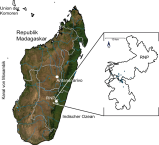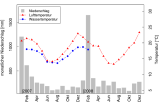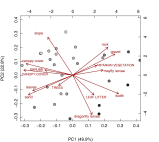TADPOLE PORTAL
The second confusing thing about Australia are the animals. They can be divided into three categories: Poisonous, Odd, and Sheep.
Jeremy Lee, "The confusing country"
Tadpole communities as model system
Amphibians of Madagascar are a prime example of species richness and endemism on this old island. In the last decade, the number of Madagascan frog species known to science (373 to 465 in 2009) increased rapidly. This was possible due to intensive field surveys and the new molecular methods: DNA barcoding allows not to focus only on frogs but also on the tadpoles, which are often much less known than adults. These tadpoles form communities of high spcies richness and diversity which are a fantastic model system to (1) gain basic knowledge of tropical amphibians and to (2) focus on general questions regarding community ecology.
Ecology and Evolution
Amphibians of Madagascan rainforests use streams for reproduction much more often than amphibians from other comparable regions do. Nowhere else in the world tadpoles of as many species occur together in streams – up to 22 species within a 30-m stream section. We have identified several habitat parameters that are of importance for differences in species richness. Interestingly, these are primarily parameters of the tadpole habitat, such as size and slope of the stream. Parameter of the adults’ habitat, i.e., characters of the forest, are of less importance for species richness. We could show for the first time that specific composition of these species rich tadpole communities depends on specific habitat variables. In contrast to the number of species, the composition is also influenced by adult habitat. Specific kinds of frogs, such as tree frogs or leaf litter frogs often produce specific kinds of tadpoles. However, there are several exceptions from this rule.
A point of general ecological interest that we were dealing with is how to measure diversity. How is species richness of a community (the simplest measure of diversity) related to the ecological functions provided by these species? We could show that species richness is a valuable measure of diversity. However, functional diversity (FD) provides more information, e.g. regarding redundancy and assembly rules, also in primary habitats. It was also interesting to see how seasonal climatic changes influence species assembly: there was low FD in the wet season but high FD in the dry season. As another measure of diversity, we have applied phylogenetic diversity (PD). PD also provides much more information on communities than species richness. Interestingly, PD is by far not congruent with FD.
Co-operations
In context of this project funded by DFG there are still co-operations running. An impressive amount on morphological data on tadpoles will be handled by Roger Daniel Randrianiana. Tadpole descriptions and comparisons of phylogenetic and morphological data will reveal evolutionary patterns. Upcoming results will be summarised here later on.
Understanding the food webs of our streams is a subject handled by Julian Glos from Uni Hamburg, hopefully also finding a satisfying answer on the question “What do tadpoles really eat?”


